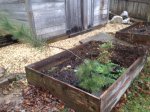May I suggest that you change your proposed method? Getting a sacrifice branch to come from the lower trunk is not easy. Even if you let one grow, it won’t be until it is the highest point on the tree that it will start to grow vigorously. It might take two or three years before it’s the tallest point and THEN it starts to be vigorous and build wood. After a couple years, you cut it off. Now what do you have? A huge scar on the lower trunk!
No, the way to build a trunk is by repeated chops of the mainline trunk. Chop the trunk where you have several branches. Choose one to be a branch, one to be the next section of trunk, and one to be the sacrifice. It’s best if the sacrifice is in the rear, but it really doesn’t matter. Let the sacrifice run for a couple years, keep the branch and next trunk section
cut back. Here’s the thing: a sacrifice branch coming from the top of the tree will build wood faster than a sacrifice lower down. The tree assumes the sacrifice will be the trunk, so it puts wood on the sacrifice, and all parts below it. It also heals wounds faster. So, about the time when the chop is covered over, it’s time to remove the sacrifice.
Next, look at your next section of trunk, and find another good place to repeat the process. Find a branch, a new trunk and a new sacrifice. And repeat the process. As many times as it takes until you are satisfied with the size of the trunk.
This builds taper. It also heals the scars from the sacrifice branches. It’s not fast, but it makes the best trunks.
Guys, please remember that the guy in the Bonsai Today article was making SHOHIN JBP! Once you get to a 3 inch trunk, that’s about as big as you can squeeze into a Shohin pot. If you’re going for a larger than Shohin tree, in the ground is the way to go.
@Anthony: remember that article is a translation of a translation from Japanese to Spanish to English. There are errors. The ages of the trees pictured is probably wrong, as no one else has been able to replicate his results. (An experiment is only considered to be valid if it is reproduceable. That is, others can do the same thing and achieve the same result. No one has.). And interestingly, I have not heard of any others advocating the double colander technique. For regular sized bonsai, the Japanese field grow their trees.




